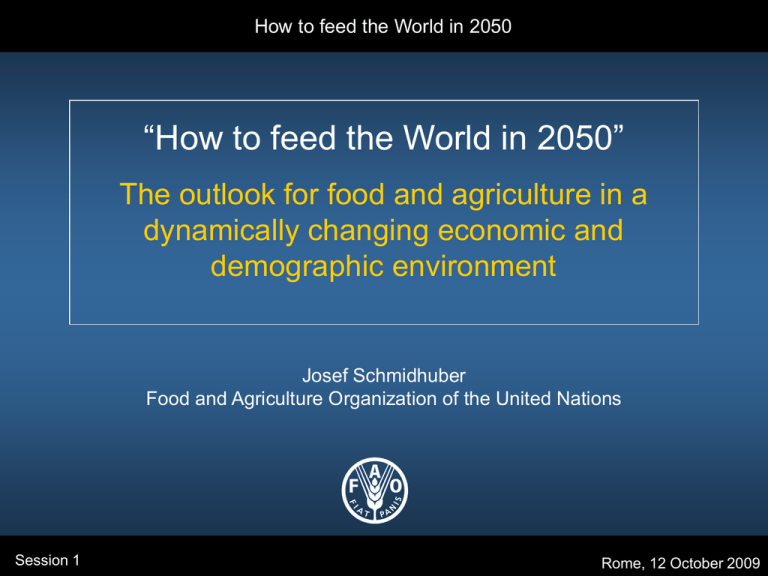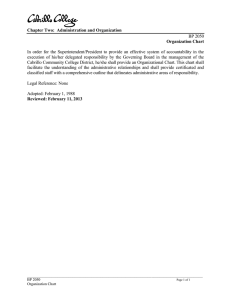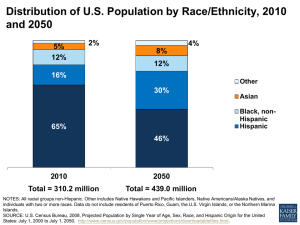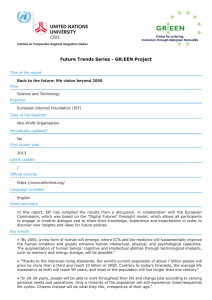“How to feed the World in 2050” dynamically changing economic and
advertisement

How to feed the World in 2050 “How to feed the World in 2050” The outlook for food and agriculture in a dynamically changing economic and demographic environment Josef Schmidhuber Food and Agriculture Organization of the United Nations Session 1 Rome, 12 October 2009 How to feed the World in 2050 The key challenges Session 1 Feed 9.2 billion by 2050, feed them better and provide more nutritious food Produce feedstocks for a potentially huge bioenergy market Contribute to overall development and poverty reduction Cope with scarce resources and shift to more sustainable production methods Adapt to the agro-ecological conditions of climate change and help reduce GHG emissions Rome, 12 October 2009 How to feed the World in 2050 The dynamically changing environment Population growth: Income growth: Session 1 +2.3 bn to 2050 after +3.3 bn over the last 40 years Highest growth in poorest region: SSA +114% Lowest growth in richest region: E and SE Asia +14% +2.7 bn in urban areas, massive urbanization Overall a richer world by 2050 +2.9% growth p.a. for the world as a whole, higher in DCs lower in ICs Convergence, less inequality (country basis) Less poverty, but low poverty line of $1.25 Rome, 12 October 2009 How to feed the World in 2050 12.0 0.9 0.8 Total population (billions) 9.0 0.7 0.6 6.0 0.5 0.4 0.3 3.0 0.2 0.1 0.0 1750 1800 Session 1 Annual increments (billions) Population growth to continue, but at a slower pace 0 1850 1900 1950 2000 2050 Source: UN, World Population Assessment 2006 Rome, 12 October 2009 How to feed the World in 2050 The food outlook Food production: slow down in growth Food trade: rapid expansion overall Session 1 DC net imports cereal: 125 million t 300 million t DC net exports oilseeds: 8 million t 25 million t DC net exports sugar: 10 million t 20 million t Food prices +70% between 2005/07 and 2050 +1,000 million t of cereals (from 2,200 million t today) +200 million t of meats (from 270 million t today) +300 million t of soybeans (from 215 million t today) Secular downward trend in real prices to discontinue? Energy price link to become more important Bioenergy demand: wildcard for production, trade and prices Rome, 12 October 2009 How to feed the World in 2050 Nutrition, hunger & malnutrition Higher calorie availability Lower levels and incidence of hunger From 823 m (16.3%) in 2003/05 to 370 m in 2050 (4.8%) WFS target of halving the absolute numbers only in the 2040s! Progress in reducing hunger, but insufficient Higher levels of overweight and obesity Session 1 World: 2770 3050 kcal/p/d DCs: 2680 2970 kcal/p/d More NCDs (diabetes 2, coronary heart disease, etc.) Growing double burden of malnutrition, from “food poverty” to “health poverty” Rome, 12 October 2009 How to feed the World in 2050 Is there enough crop land? Session 1 huge potential: 4.2 billion ha 1.60 billion ha in use today, increase to 1.67 billion ha by 2050 But land reserves unevenly distributed: ample in SSA and LA, exhausted in NENA and SASIA and: 800 mha covered by forests, 200 mha in protected areas, 60 mha in settlements Rome, 12 October 2009 How to feed the World in 2050 Is there enough yield potential? Sources of growth: predominantly through higher productivity (as in the past) 77% yields, 14% CI, 9% area 71% yields, 8% CI, 21% area Yield growth: considerable slow down: 0.8% p.a. in the future compared to 1.7% in the past Yield potentials Session 1 World: DCs: Still considerable untapped/bridgeable yield potentials Intensification possible to narrow yield gaps Technology potential to raise yield ceilings but: R&D needed for crops that are important for the poor (millet, sorghum, R&T, pulses, plantains) Rome, 12 October 2009 How to feed the World in 2050 Is there enough water? Area equipped with irrigation Water withdrawals: “only” +11% Session 1 World: +31 mha to 318 mha DCs: +32 mha to 251 mha AH under irrigation: +17% Higher water use efficiency Decline of irrigated rice area Resource “pressure”: withdrawals as share of renewable water resources relatively low for the world as a whole, but very high in NENA (58->62%) and high and rising in SASIA (36->39%) Rome, 12 October 2009 How to feed the World in 2050 Agricultural transformation Vibrant agricultural sector needed for a successful economic transformation Low food prices and labour surplus stimulated economic growth in developed countries, absorption of rural labour, pull effect For developing countries to enter into a similarly successful transformation, more investment in agriculture is crucial (infrastructure, institutions, R&D, extension, food safety nets, productive safety nets, resource conservation) Session 1 Rome, 12 October 2009 How to feed the World in 2050 Conclusions Session 1 The world has the resources (land, water, genetics and know-how) to feed 9.2 billion people by 2050 Food security is a predominantly a poverty problem; but no success in poverty/hunger reduction without improvements in agriculture The poor depend on agriculture and they are disproportionately more affected by CC, higher food and energy prices Agriculture is the Poor's (and the world’s) best hope: Investments in agriculture are key to reducing poverty, hunger, adapting to and mitigating climate change Rome, 12 October 2009




